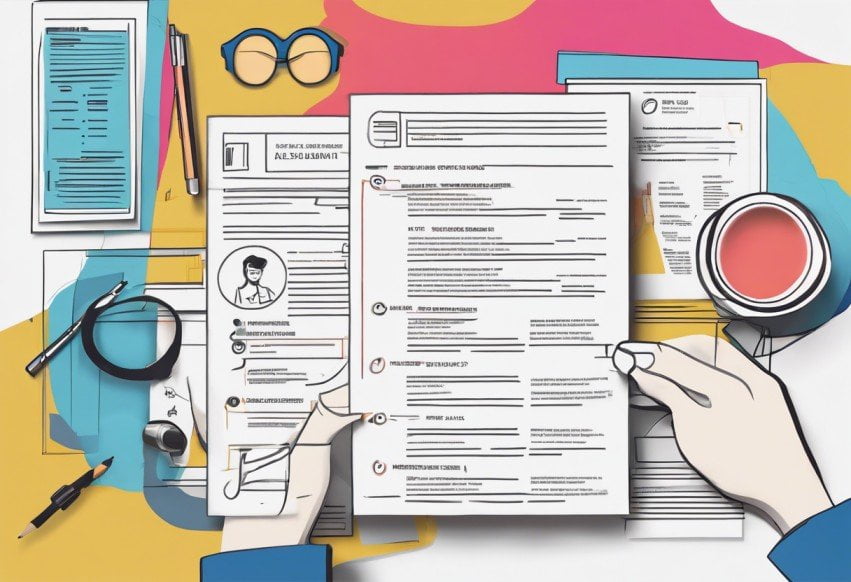In the fast-paced digital era, job hunting has evolved, and so have the tools recruiters use to streamline their hiring processes. One such crucial tool is the Applicant Tracking System (ATS). To navigate this digital gateway successfully and land your dream job, crafting an ATS optimized resume is paramount. Let’s delve into the intricacies of this indispensable document that can make or break your job prospects.
Understanding the ATS: A Digital Gatekeeper
Before we dive into the nuances of an ATS optimized resume, it’s crucial to comprehend the role of the Applicant Tracking System in the modern recruitment landscape.
Let’s demystify the term “ATS” for you. The ATS acts as a gatekeeper – keeping away irrelevant and non-optimized resumes and CVs from the employer.
ATS scans through the multitude of resumes received for a job opening and selects those that best match the predefined criteria set by the employer.
How do Recruiters Use ATS to Find Candidates?
Ever wondered how recruiters unearth the perfect candidates in the vast sea of resumes?
Well, it’s all about keywords, my friend!
Picture this: Your resume is like a treasure map, and the ATS is the savvy pirate captain searching for that coveted treasure (aka the ideal candidate).
Now, here’s the secret: if you write an ATS Optimized Resume then voilà! Your resume match rate is high and you’re on the radar.
What is Your Resume Match Rate? Your match rate reflects how well your resume aligns with a job description. A higher match rate increases your chances of getting noticed by recruiters.
Crack the Code to Career Success with ATS-Optimized Resumes!
Ever felt the frustration of pouring your heart into a resume only to have it REJECTED by an ATS, leaving you wondering, “Did a robot just Swipe Left on my dream job?”
Well, you’re not alone, my friend!
98% of Fortune 500 companies are using ATS to play matchmaker between employers and candidates. But here’s the catch – if your resume does not speak the ATS language, it might end up in the digital rejection pile faster than you can say “Dream Job.”
Let’s face it; getting rejected by a robot is not the future we envisioned.
Now, you might think, “I’ve got the keywords; I’m good to go!” But hold on!
Even if your resume is keyword-rich, it could still get lost in translation if it doesn’t meet the ATS’s criteria. These sophisticated systems might fumble with irregular formats or intricate designs, leading to your resume being tossed into the digital abyss.
Ready to take the reins and craft your own destiny?
We’ve got the DIY secrets to penning an ATS-Optimized Resume. Let’s break the barriers between you and your dream job – and analyze a Job-Landing Resume.
The Anatomy of an ATS Optimized Resume
1. Find & Select appropriate keywords
Thoroughly review the job description and incorporate industry-specific keywords. This increases your chances of standing out in ATS scans. ATS scans for certain keywords set by the employer throughout the scanning process.
Resumes that lack job-related keywords are frequently discarded. The following points will help you find and use the keywords for your resume:
- One of the best ways to determine what keywords you can use is to read the job description provided in the listing.
- Look for role-specific phrases that appear in the article several times.
- The more popular a keyword is, the more weight you should give it to your resume.
- Place these keywords throughout as necessary, but avoid over-stuffing your resume with them.
2. Strategic Keyword Placement
One of the key elements in creating an ATS optimized resume is strategic keyword placement. Identify industry-specific terms relevant to your skills and experience and incorporate them organically into your resume.
While keywords are crucial, striking a balance is key.
Overloading your resume with keywords may trigger spam alerts in the ATS, leading to your resume being discarded. Focus on relevance and coherence, ensuring your document is both human-readable and algorithm-friendly.
3. Clear and Readable Formatting
While creativity is essential, maintaining a clear and readable format is equally vital.
ATS systems favor simplicity. Ensure your resume uses standard fonts, bullet points, and section headings to enhance readability. This not only pleases the algorithms but also ensures a positive reading experience for potential employers.
4. Use simple layouts or designs
Avoid complex designs that ATS may struggle to read. Opt for clear, straightforward layouts to enhance readability.
Some companies prefer resumes with personality and character, depending on the business. It gives them more information about each prospect. Some resumes and resume templates, on the other hand, have jarring designs that result in disorganized layouts.
ATS is unable to read complex layouts. If it attempts to, chances are high that it chooses the wrong information for employers or downgrades the resume altogether, potentially removing it.
5. Tailoring for Each Job Application
A one-size-fits-all approach doesn’t work in the realm of ATS optimized resumes.
Tailoring your resume for each job application increases its chances of passing through the digital gatekeeper. Highlight the skills and experiences most relevant to the specific job, demonstrating a genuine interest in the role.
6. Select appropriate terms
Once you have a full understanding of these systems, proper terminology and usage become clear. These systems scan papers for assigned keywords and discard those that have the fewest.
Use a lot of industry- or role-specific jargon, and study the job description thoroughly for additional phrases. With the job-specific language, you may put your resume at the top of the pile without overcrowding it.
7. Include precise information.
Be precise when explaining previous roles and duties as well as your objective, if necessary.
Mention your experience in Active-Voice sentences and make the bullets Result-Oriented.
Even within the same field, several positions exist, and employers search for different keywords. Examine every job advertisement carefully and tweak your CV to make it the best candidate for each opportunity.
8. Naming your ATS Optimize Resume
When submitting your resume online, use a clear and descriptive file name, such as “John_Doe_Sales_Manager_Resume.pdf,” rather than generic names like “Resume2023.pdf.”
This makes it easier for ATS to identify and categorize your document.
9. Include a Summary
Begin your resume with a summary highlighting your qualifications, skills, and career goals.
This allows ATS to quickly identify key information about you.
10. Proofread and Format Consistently
Errors in grammar, punctuation, or formatting can confuse the ATS and lead to rejection.
Proofread your resume thoroughly and maintain consistent formatting throughout.
11. Use the relevant file type
While PDFs are excellent at preserving file data without compromising integrity, they’re not always best suited for ATS.
There are many different kinds of tracking software, but not all of them accept PDFs. Make sure to check for a list of accepted file types before uploading a resume. If it doesn’t list PDF as a viable option, upload a .doc or .docx version of the file.
12. Test Your ATS Optimized Resume
Before submitting your resume, use ATS-friendly tools like Jobscan or Resunate to assess how well your resume matches the job description and identify areas for improvement.
 If you are getting overwhelmed by these points, we understand you – Navigating the intricacies of ATS optimization can be a bit like deciphering complex code.
If you are getting overwhelmed by these points, we understand you – Navigating the intricacies of ATS optimization can be a bit like deciphering complex code.
But fear not. Our team of Resume Experts is here to guide you through the algorithm of ATS optimization.
We don’t believe in just scratching the surface. No, sir!
We take a deep dive into the world of optimization, ensuring your resume isn’t just a needle in the haystack but a shining beacon that recruiters can’t ignore. It’s not just about keywords; it’s about strategic brilliance that propels your resume miles ahead of the competition.
These are not just words!
Check out the success stories of those who’ve entrusted their career journey to us in our glowing testimonials. Whether you’re a seasoned professional or a fresh graduate, our team has your back.
Our Services & Testimonials
Common Mistakes to Avoid in ATS Optimized Resume
Here are some common mistakes you should avoid while crafting your ATS optimized resume:
1. Excessive Graphics and Formatting
While a visually appealing resume is tempting, excessive graphics and complex formatting can confuse the ATS. Stick to a clean and professional layout to ensure seamless parsing of your resume. ATS cannot read images, charts, and other graphics. Some candidates exhibit their skill levels in certain areas by showing them within charts. The only way an ATS captures that information is if it also appears within another section. When choosing or creating an ATS resume template, avoid these as much as necessary.
2. Neglecting Spell Check
Typos and grammatical errors are not just a turn-off for human readers; they can also adversely affect your resume’s performance in an ATS. Prioritize thorough proofreading to present an error-free document.
3. Ignoring the Importance of File Format
ATS systems prefer simple file formats like .docx or .pdf. Avoid using unconventional file formats that may result in compatibility issues, hindering the ATS’s ability to read your resume.
4. Avoid Special Characters
ATS systems may struggle with special characters or symbols. Stick to standard characters and bullet points to ensure your resume is properly formatted.
5. Avoid header and footer details
Not all tracking systems are capable of properly reading and comprehending things in the header and footer. Candidates frequently leave their contact information in these spaces. If an ATS doesn’t read this information, the ATS might lose your contact details and have nothing for the employer to go by. Place your name, phone number, and email address in other parts of your resume template to avoid this.
Frequently Asked Questions About ATS Resume Optimization
1. How can I test the level of my ATS optimized resume?
Use online ATS scanning tools or platforms (i.e. Jobscans) to test your resume before submitting applications.
2. Are all ATS systems the same?
No, different ATS systems may have varying parsing capabilities. However, adhering to general ATS optimization guidelines improves compatibility across systems.
3. Can using synonyms and varied wording in my resume help with ATS optimization?
Yes, incorporating synonyms and diverse language relevant to your industry can enhance your resume’s chances of getting through ATS filters and reaching the eyes of recruiters.
4. How often should I update my resume for ATS optimization?
Regularly updating your resume is beneficial not only for reflecting your latest achievements but also for staying in tune with changing industry keywords and trends, ultimately improving its ATS compatibility over time.
Conclusion: ATS Optimized Resume – Pathway to Career Triumph
In conclusion, an ATS-optimized resume is a key to unlocking career opportunities in the digital age.
By strategically incorporating keywords, maintaining clear formatting, and tailoring your resume for each application, you not only appease the ATS but also capture the attention of potential employers. Steer clear of common mistakes, let your resume shine, and watch as doors to coveted career paths swing open, propelling you toward a future of endless possibilities.
By following these guidelines and utilizing the resources available, you’re well-equipped to navigate the intricate landscape of ATS-optimized resumes.
Remember, the goal is to create a document that seamlessly aligns with both ATS algorithms and human reader expectations, giving you a competitive edge in the job market. If you want to optimize your resume for a specific ATS system and job requirement.
Let us make your resume an ATS favorite – because who says job hunting can’t be an epic adventure?
Get ready to conquer the job market with our expertly written ATS optimized resume
Good luck on your journey to career success!








Aw, this was a really nice post. Thank you for the detailed information on ATS topic
Thanks , I have recently been looking for information about this topic for ages, and yours is the best I have discovered till now.